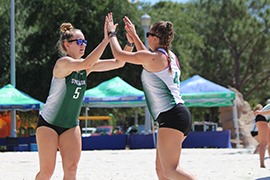Hatters Excel Off the Field in New NCAA Report


Ten Hatters sports programs earned perfect single-year scores, and two programs earned perfect multiyear scores in the 2018-2019 NCAA Academic Progress Rate Institutional Report, officially unveiled this week.
The complete scoreboard: Each of Stetson’s 17 NCAA sports performed extremely well, posting APR scores above 960 — a perfect score is 1000 — while 12 programs topped the 980 mark. (Men’s rowing is not an NCAA championship sport.)

The 10 programs to achieve perfect 1000 single-year APR scores for the 2018-2019 academic year were beach volleyball, men’s cross country, women’s cross country, men’s golf, women’s golf, men’s tennis, women’s tennis, lacrosse, softball, and volleyball.
The two Hatter teams with perfect 1000 multiyear scores were beach volleyball and men’s cross country. Those two programs also recently were honored with NCAA Public Recognition Awards for posting APR scores in the top 10% of their sport.
The other Stetson programs achieving high multiyear APR scores were women’s soccer (989), lacrosse (987), men’s golf (986), indoor volleyball (984), men’s tennis (984), softball (982), women’s golf (982), women’s tennis (982), men’s soccer (981), women’s cross country (981), women’s basketball (979), baseball (974), women’s rowing (973), football (968), and men’s basketball (962).
Not surprisingly, Stetson Athletics Director Jeff Altier was thrilled with the outcomes.

“In other words, the athletes we are recruiting are succeeding academically at Stetson!” he said.
The Academic Progress Rate, implemented in 2003 as part of an ambitious academic reform effort in Division I, holds institutions accountable for the academic progress of their student-athletes through a team-based metric that accounts for the eligibility and retention of each student-athlete for each academic term.

The APR emerged when Division I presidents and chancellors sought a timelier assessment of academic success at colleges and universities. At the time, the best measure was the graduation rate calculated under the federally mandated methodology that was based on a six-year window and did not take transfers into account.
The APR is calculated as follows:
- Each student-athlete receiving athletically related financial aid earns one point for staying in school and one point for being academically eligible.
- A team’s total points are divided by points possible and then multiplied by 1,000 to equal the team’s Academic Progress Rate.
- In addition to a team’s current-year APR, its rolling four-year APR is also used to determine accountability.
While the APR is intended as an incentive-based approach, it does come with a progression of penalties for teams that underperform academically over time.
Yet, that hasn’t been the case for the Hatters in the past — and certainly wasn’t this time.
– Jamie Bataille



